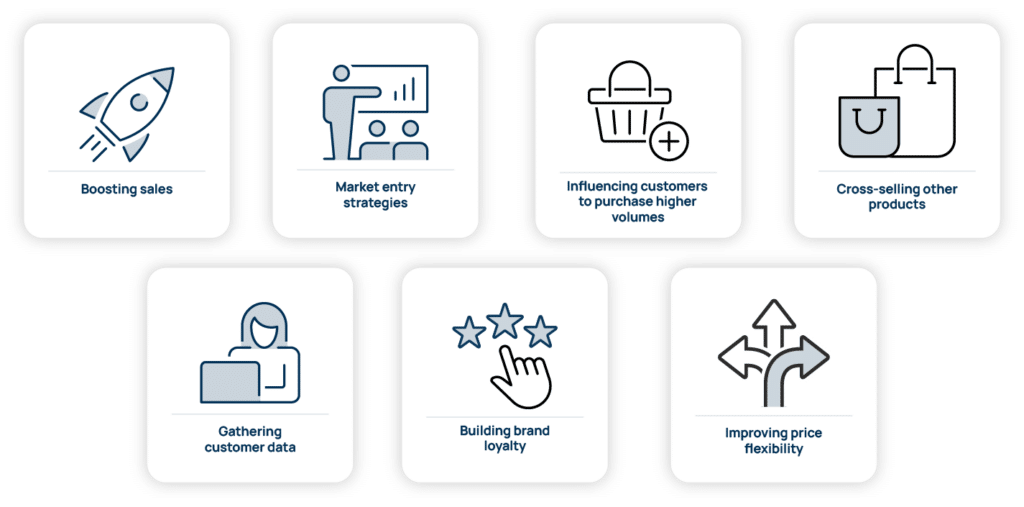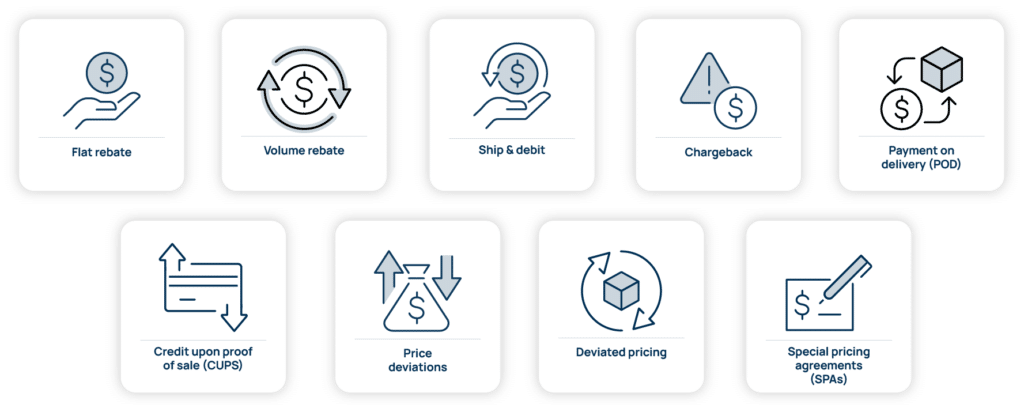
Rebates are a key element in a successful business strategy, but you need the right system in place to make them as effective as possible. In this article, Paul Sansom, Business Consultant at Vendavo, explains the ins and outs of rebate accounting — including the challenges, procedures, and solutions that make the biggest impacts.
Since Vendavo acquired Market Medium in June of 2022, I have learned about the broad, confusing, and often-tangled world of rebates and rebate management. Like many consumers, I associated customer rebates with a hefty packet of paperwork that comes with purchasing a new couch, which promises $50 back if you fill it out and then wait 2 to 8 weeks. That packet typically finds its way into a pile of other similar offers, to be eventually thrown away 18 months later when the pile becomes tall enough to harm a small child if toppled.
Despite the stigma around customer rebates, you are probably aware that the ecosystem of rebates and other incentives is so much more. As such, the management and accounting for customer rebates introduce complexities for organizations that rely on seamless recording and fulfillment of such incentives to operate efficiently.
What are Customer Rebates?
At their most basic level, customer rebates are price or sales promotions that return a portion of the sales price to the buyer. Rebates have gained traction as an effective promotional tool designed to encourage more purchases, elevate sales figures, and foster customer allegiance. They not only serve as incentives but also as a mechanism for businesses to nurture and deepen relationships with their clientele.
The intricacies of managing customer rebate programs involve several key steps – from the initial setup and fine-tuning of agreements to scrutinizing margins for profitability. It’s about creating a frictionless system where deals aren’t just made but efficiently managed over time for mutual gain. This accounting and management process is pivotal in carving out profitable engagements while simultaneously reinforcing brand loyalty through improved customer interactions.
At every stage—be it defining eligibility criteria for rebates, selecting products that qualify, or determining how payments will be disbursed—the goal remains clear: streamline the management and accounting for rebates in such a way that both parties benefit significantly. By doing so, companies can ensure they’re not only rewarding their customers but also paving the path towards a healthy and accurate bottom.
Customer rebates are important tools for incentivizing and driving certain behaviors in your end customer. Rebates are typically used by manufacturers, wholesale distributors, financial services firms, and retailers as a mechanism for:

- Boosting sales by increasing demand for a product with an incentive
- Market entry strategies to influence new customers to purchase your products at more advantageous prices
- Influencing customers to purchase higher volumes of your products than historical levels
- Cross-selling other products in your portfolio that your customer may be interested in can also be used to clear inventory of slow-movers.
- Creating competitive advantages in markets where your peers offer similar products for similar prices.
- Gathering customer data by asking simple questions that relate to purchasing decisions and drivers when customers submit rebate claims
- Building brand loyalty when customers have a simple and positive experience with your product and receipt of the rebate
- Improving price flexibility through adjusting prices without making permanent changes to the base price of your products
Rebates are often critical elements of the commercial process for many businesses, as they give your sales and commercial teams a weapon in the ever-changing battle for market share against your competition.
Importance of Accounting for Customer Rebates
Rebates must be recorded following recognized accounting standards, including Generally Accepted Accounting Principles (GAAP) or International Financial Reporting Standards (IFRS), and often impact the timing and revenue recognized by your company.
Depending on the terms of the rebate program and applicable accounting rules, revenue from sales involving rebates may need to be recognized at the time of sale or deferred until the rebate is fulfilled or treated as a reduction of sale price rather than a reduction of revenue. Failure to properly account for rebates can lead to misstated revenue figures, which can mislead management, investors, and stakeholders.
Accounting for customer rebates is a crucial component in managing these incentives, largely due to the impact on financial reporting, compliance, and performance evaluation.
- Financial Reporting Impact: Accounting for customer rebates is crucial as it directly influences a company’s financial statements. By accurately recording these transactions, businesses ensure that their revenue and expenses reflect true figures, fostering transparency.
- Compliance and Accountability: Proper documentation of rebate transactions helps in adhering to financial regulations, thereby minimizing audit risks. It establishes a framework of accountability, enabling stakeholders to evaluate the company’s fiscal health with clarity.
- Performance Evaluation: The meticulous accounting of customer rebates allows for an accurate assessment of business performance. This analysis is instrumental in managing profitable deals more effectively and enhancing relationships with customers.
- Process Involvement: The management aspect covers setting up agreements, defining eligibility criteria for rebates, selecting qualifying products, and deciding on payment methods. These steps are fundamental in maintaining organized rebate programs.
- Audit-proof Financial Statements: Implementing robust inventory rebate accounting processes guarantees that financial reports are prepared for audits without discrepancies or unexpected findings.
- Utilization of Rebate Management Software: Recent research has found that 51% of CFOs and general managers at top manufacturing and distribution companies still rely on manual processes or in-house applications to manage rebates. Adopting rebate management software aids in pinpointing eligible transactions swiftly and calculating rebates based on program specifics. Benefits include increased accuracy, time efficiency, better customer service standards, and the elimination of manual spreadsheets.
Rebate programs are often managed or overseen by the finance and accounting groups in many companies. This is due to the importance and impact of rebates on accounting, auditing, and compliance processes, and thus the underlying financial health and integrity of the entire organization.
Types of Customer Rebates
Throughout my rebate education journey, my eyes have been opened to just how many different types of rebates and incentive programs can be used by global organizations. As I said in the beginning, this world can be confusing to outsiders and insiders alike, primarily due to the varying names that are used by different industries for the same process.

Below are some of the more common methods manufacturers, wholesale distributors, financial services firms, and retailers use to influence and incentivize the end customer.
Flat Rebate
The most common form of a rebate is where a nominal or percentage value is paid out based on the total spend or units purchased. For example, a rebate can be set for the customer to receive $1 back for every purchase of an individual item or for every $X amount of total spend accrued during a specified timeframe, which is often accrued annually, quarterly, or monthly.
Sales Rebates
These are incentives offered to customers post-purchase based on the sale value of the product. The key idea is straightforward: the more a customer spends, the larger the rebate they receive. Sales rebates are powerful tools for boosting short-term sales and encouraging buyers to spend more during each transaction, enhancing overall revenue generation.
Volume Rebate
This type of rebate sets specific spending tiers for the customer to reach, and the program incentivizes the purchase of higher volumes of products throughout the life of the agreement. A nominal or percentage value will increase as more money is spent with you or more volumes are purchased.
Volume rebates are commonly established by dollar or unit “tiers”. A customer may receive a 1% rebate on the first thousand units, a 2% rebate for the next thousand, and so on. Volume rebates are also referred to as “growth rebates.”
Purchase Rebates
Purchase rebates focus on rewarding customers simply for buying products, irrespective of quantity or total spend. This type encourages new customers to try a brand’s offerings and loyal ones to continue their patronage. By offering a portion of the purchase price back, companies aim at increasing product uptake and building long-term relationships with their clientele.
Product-specific Rebates
These rebates apply exclusively to certain products as part of promotional campaigns aimed at driving interest in new launches or clearing inventory for older stock. By targeting specific items with attractive offers, companies can direct consumer attention where needed most—be it pushing cutting-edge innovations or maximizing returns from end-of-line goods.
Ship & Debit
Ship & Debit is a mechanism in which a distributor ships goods at a lower price to the customer and either debit the manufacturer for the difference in the acquisition and selling price. The customer can request this new price or the distributor can decide on this price to make a bulk sale, retain a customer, or interest a new customer. To debit the supplier for the difference, the distributor raises a supplier ship and debit request for the new price and sends it for supplier approval.
The name “Ship & Debit” varies greatly across industries, despite being a similar process, including:
- Medical Industry often refers to it as, simply, a rebate
- Equipment Manufacturers often refer to it as a chargeback
- Packaging companies often refer to it as a POD, or Payment on Delivery
- Process Manufacturers and Chemical Companies often refer to it as CUPS, or Credit Upon Proof of Sale
- Distributors/Wholesale Distributors often refer to it as price deviations or deviated pricing
Special Pricing Agreements (SPAs)
These are a common vendor rebate program in many industry sectors, where the vendor gives a special product discount for verified sales to an ultra-competitive event where in-stock discounts can’t secure the order.
SPAs are commonly used in B2B engagements where a supplier may offer special pricing to a particular customer in exchange for a long-term commitment or a guaranteed volume of business. They can provide a level of predictability and stability in channel pricing for both the supplier and the customer, helping establish a mutually beneficial relationship.
These rebate programs can be applied to an individual product, a family of products, or even spread across your entire portfolio. In addition, individual customers may have different agreements, payment terms, and management structures in place. Therefore, as the number of active rebate programs grows and the complexity increases, managing all of the accruals, claims, and payments can quickly become a daunting task if performed manually.
Financial Statements and Customer Rebates
Customer rebates, while a powerful tool for driving sales and fostering customer loyalty, introduce significant complexity into financial accounting processes. Their management requires precision to ensure that financial statements accurately reflect the company’s economic activities.
Impact of Customer Rebates on Financial Statements
A profitable rebate strategy can have a significant impact on an organization’s financial statements, particularly affecting revenue recognition and expense reporting. When accounting for customer rebates, businesses must adjust their reported revenues or recognize additional expenses to reflect the cost of rebate programs accurately. This adjustment is crucial in providing stakeholders with a transparent view of the company’s financial performance, ensuring that reported figures truly represent the company’s operational efficiency and profitability.
In practice, this means adjusting income statement entries to either lower sales revenue by the expected rebate amount or increase expenses to account for these outflows. Such adjustments are essential not only for maintaining accuracy in financial reporting but also for upholding stakeholder confidence by demonstrating fiscal responsibility and transparency.
The recording and treatment of a rebate typically depend on the specific terms of that rebate and whether they are considered sales incentives or price reductions.
Sales Incentives (Conditional Discount):
- If the rebate is considered a sales incentive, it is recorded as a reduction of revenue at the time of sale. This means that the gross revenue from the sale is initially recognized, but an estimate of the rebate liability is recorded as a reduction to revenue in the same accounting period.
- The estimated rebate liability is recorded as a separate account on the balance sheet, often classified as a liability or contra-revenue account.
- When the rebate is redeemed by the customer, the liability account is reduced, and the actual rebate expense is recognized in the income statement.
Price Reductions (Unconditional Discounts):
- If the rebate is considered a price reduction, it is treated as a reduction of the sales price rather than a reduction of revenue.
- The rebate is recorded as a revenue reduction at the time of sale, resulting in a lower net sales figure on the income statement.
- No separate liability account is typically established for price reduction rebates since they are considered to reduce the sales price directly.
Effective management of customer rebates requires careful tracking and projection of redemption rates against actual claims to mitigate potential impacts on profit margins. Transparent reporting practices enable organizations to manage expectations around their bottom line more effectively while adhering to compliance requirements.
Accurate accounting for customer rebates is key in navigating economic challenges associated with promotional strategies, ultimately contributing to sustainable business growth.
Balance Sheets
Customer rebates exert a notable influence on an organization’s balance sheet, presenting accounting challenges that require meticulous management to ensure fiscal accuracy and compliance. This impact primarily revolves around how rebate liabilities are recognized and managed over time.
Initially, when rebates are offered by suppliers or extended to customers, they introduce potential obligations that businesses must account for as liabilities on their balance sheets. These liabilities reflect the company’s future cash outflows earmarked for rebate payments—a critical aspect of financial reporting that demands precision.
Accurately tracking these amounts is vital because it directly affects the valuation of inventory and overall asset figures reported in the balance sheet. When companies receive rebates from suppliers, this effectively lowers the cost basis of their stock—adjusting inventory values to a net-of-rebates level which more accurately represents current assets’ true worth.
However, recognizing these reductions in value requires careful accrual accounting; only once related products have been sold can these adjustments be transferred from the balance sheet to profit and loss statements as realized gains.
Income Statements
Rebates necessitate specific accounting treatments that directly affect how a company’s profitability is reported. Essentially, these incentives can either diminish reported revenues or elevate expenses—depending on their nature and application within sales transactions. This distinction is critical for ensuring stakeholders gain an accurate understanding of financial performance over reporting periods.
For instance, when rebates are offered to customers, companies must account for them by reducing the gross revenue expected from sales by the anticipated rebate amount—a practice aligning with conservative revenue recognition principles. This adjustment ensures that only net sales figures—revenue after deducting forecasted rebate payouts—are reflected in income statements, offering a truer picture of earnings derived from core business activities. Conversely, if viewed as direct costs incurred to generate sales (e.g., marketing expenses), rebates increase operational expenditures thereby impacting profit margins.
Accurate representation of these dynamics within income statements underscores not just fiscal responsibility but also compliance with prevailing accounting standards such as IFRS 15 or ASC 606 which guide revenue recognition practices globally. For businesses aiming to maintain credibility among investors and lenders, robust processes around tracking and reporting customer rebates become indispensable tools in safeguarding integrity across financial disclosures.
Businesses must have robust processes and systems in place to accurately account for customer rebates and ensure compliance with relevant accounting standards. Many organizations turn towards specialized rebate management software solutions. Such tools streamline processes involved in identifying eligible transactions for rebates and calculating precise rebate amounts based on specific program terms. Through automated tracking and reconciliation features, organizations can reduce picing errors associated with manual entry while optimizing their compliance efforts.
Recording Customer Rebate Transactions
Accurately recording customer rebate transactions is a cornerstone of sound financial management and compliance. To navigate the intricacies associated with these incentives, businesses should adhere to several accounting best practices that ensure accurate reporting and operational efficiency.
Proper Documentation and Record Keeping
The foundation of effective rebate accounting lies in meticulous documentation and record-keeping. Every transaction related to rebates—whether it’s issuing, modifying, or fulfilling them—requires comprehensive records.
This includes detailed information about the transaction dates, amounts involved, parties to the agreement, terms, and conditions of the rebates offered, and evidence of fulfillment or redemption by customers. Maintaining organized records aids in audit trail creation and facilitates easier review during internal audits or external regulatory checks.
Recognizing Rebate Expenses and Liabilities
Recognizing expenses related to customer rebates at the right time is crucial for accurate financial reporting. Businesses must account for anticipated rebate claims as liabilities on their balance sheets upon issuance of the rebate offer. As these offers are redeemed or expire unclaimed, adjustments need to be made accordingly—to reflect actual obligations more precisely over time.
Similarly, recognizing expenses tied directly to promotional activities involving rebates helps align reported earnings with economic realities—capturing genuine costs incurred towards generating sales through such incentive programs.
Understanding Rebate Agreements
Navigating the complexities of rebate agreements requires a thorough understanding of their terms and structures. These agreements are foundational to how rebates will impact financial reporting and necessitate careful examination by finance teams. Key elements include:
- Eligibility criteria, which outline what purchases or actions qualify for rebate
- Thresholds that trigger different levels within volume-based incentives, providing higher rebates as customers purchase more
- Timing considerations that define when achievements must be met
- Product specificity, detailing which items are eligible for rebates.
Accounting teams must familiarize themselves with these aspects to ensure accurate tracking and recording of rebate transactions. This involves dissecting each agreement to understand potential financial implications fully—such as impacts on revenue recognition, expense allocation, and liability accounting.
Automation and Finance Tools
Leveraging automation and specialized finance tools is increasingly becoming a part of rebate best practices for managing customer rebate transactions efficiently. Pricing technology and automated solutions can significantly streamline the process—from identifying qualifying transactions based on complex rebate agreements to calculating precise amounts owed under various incentive schemes.
These tools often come equipped with features designed specifically for handling the multifaceted nature of rebate management:
- Automated tracking systems maintain detailed records of all relevant sales data
- Calculation engines apply pre-defined rules from rebate agreements accurately across vast datasets
- Reporting modules generate timely insights into outstanding liabilities, redeemed offers, and overall program performance.
Managing all aspects of rebates can get complicated, real quick. We recently surveyed top CFOs and general managers in manufacturing and distribution and found 61% say their rebate program costs too much and 61% view it as a mess. Large organizations are often managing hundreds to tens of thousands of individual customer rebate programs with different terms and structures, across millions of different transactions, and accruing millions of potential claims and payments to those customers. The process for administrating all of these records and data points is often done manually…on Excel.
Effective, fully integrated rebate management systems can easily account for, and automate these end-to-end processes, from the initial set-up to the approval and execution by the customer, to automated accruals and claims management, to finally triggering and recording a payment to the customer.
Vendavo’s Rebate and Channel Manager system enables our customers to eliminate the tedious and often painful aspects of this process, by removing manual tracking, providing a line of sight into the liabilities of rebate accounting, eliminating duplicate-/under-/over-payments, improper netting of rebates, and giving your organization real-time insight into margin intelligence.
FAQs
Accounting for customer rebates can pose various questions, especially when aiming to maintain accurate financial records and comply with relevant standards. Below are FAQs that shed light on common areas of confusion regarding rebate accounting.
How Do You Record Customer Rebates in Accounting?
Customer rebates are recorded by estimating the expected amount to be redeemed and setting this aside as a liability on the balance sheet. As customers redeem their rebates, actual expenses against these liabilities are recognized, reducing both the liability account and affecting net revenue or expense accounts accordingly.
Are Rebates Considered Accounts Receivable?
No, rebates are not considered accounts receivable. Instead, they represent a future obligation by the company to provide a monetary benefit back to the customer after certain conditions have been met; hence they’re typically accounted for as liabilities until fulfilled.
Do Rebates Count as Revenue?
Rebates do not count as revenue. They reduce gross sales because they effectively lower the price paid by customers post-purchase or act as marketing expenses aimed at boosting sales volume—therefore impacting either net revenues directly or increasing operational expenses indirectly.
Are Rebates Capitalized?
Rebates are generally not capitalized. Since they relate more closely to ongoing promotional activities rather than long-term assets providing future economic benefits over several periods, recording them involves adjusting current period revenues or recognizing specific associated costs during which related transactions occur rather than capitalizing such amounts within balance sheets.
